How to Grow Pineapple at Home
You can always create an exotic corner at your home. To do this, it is enough to grow everyone’s favorite – pineapple. This tropical plant is one of the most popular ones; it blooms beautifully and also brings fruit. To grow pineapple, you will need the top of a fresh one, a pot, some soil, and very little effort. However, for those who don’t intend to bother, we recommend buying an already grown indoor pineapple. In our catalog, you can find not only flowers in Odessa, but also fruit trees for your home.
Required Conditions

The pineapple originates from the tropical regions of the sunny Brazil. It is necessary to create conditions close to natural for the plant to grow well and develop at home. We have already written on how to grow kiwi at home, and today we will share with you the rules and instructions for pineapples.
Temperature
This heat-loving plant will feel maximum comfort at a temperature of at least +15°C (59°F). Generally speaking, the usual room temperature is fine for the pineapple. Even in the summer heat, when it approaches +30°C (86°F), the plant will be comfortable. The main concern is to protect it from the sudden temperature jumps – and not forget about spraying in the peak of the heat. If your apartment becomes too hot and stuffy in the summer, you can put the pot on the loggia, terrace, or in the garden.
In the late autumn and winter, it is especially important to maintain the optimal temperature regime for the indoor pineapple. In this way, the plant can easily survive the decrease in the light period of the day. The temperature drop should be gradual to avoid root hypothermia. You can even put the pot on a stand instead of a cold windowsill. Also make sure that there are no heaters or heating systems near the pot. Draughts are extremely bad for the pineapple, but the ventilation does not harm it.
Humidity
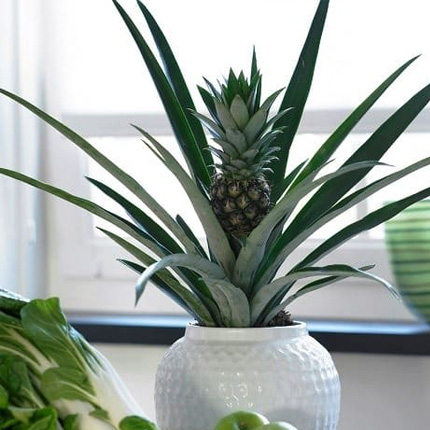
Since the pineapple is used to the wet tropics, it is recommended to create the appropriate conditions for it. The best way is to put a humidifier near the plant; however, you can do with regular spraying. Use the water from a spray gun once or twice per day in the summer and spring for the pineapple to grow quickly and develop correctly. During the heat, increase the spraying frequency twice. You can sometimes water the plant directly from the shower hose.
In the cold season, spraying can be excluded if the air at home is not very dried. Otherwise, it is still better to further moisturize the plant with water at room temperature. Do not forget to regularly water your pineapple as well; the substrate should be moist, but not overly wet. It is not difficult to understand that it is time to water the plant when you focus on the dryness of the upper soil layer. Interestingly, many gardeners recommend growing the pineapple in a bathroom with the window facing the south. In such a room, the indicators of humidity, heat, and light are considered the most optimal and balanced.
Lighting
Pineapple is a plant that loves when a lot of light falls on it. The best location for the pot is the windows facing the south or south-west. However, sometimes just keeping the plant on a sunny windowsill is not enough. Of course, there will be no problems with the lighting in the warm season, but in the gray autumn and winter, the pineapple may not feel very comfortable. Therefore, the pot with this perennial herbaceous plant must be kept on the windowsill without the slightest hint of a shadow. Take care of the artificial backlighting in winter as well; this can be either the ordinary LED lamps or the special phytolamps (modern devices that emit the ultraviolet light for seedlings).
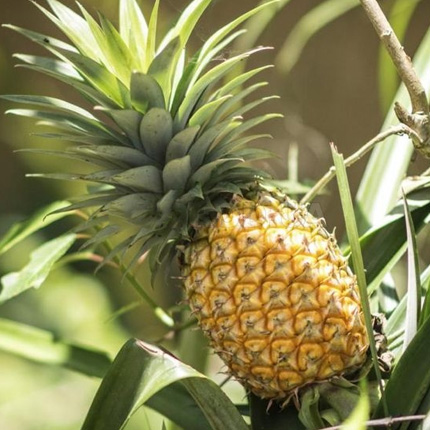
Pineapples differ by the leaf color intensity. The more saturated and brighter the greens are, the better the plant feels. This indicates that the lighting has been selected competently. The dull light-green leaves mean that the plant is not having the best time of its life and you should rethink your approach to its care. Turn the pot in the direction of the light source from time to time for the pineapple bush to develop evenly from all sides. It is also important that the plant tends to be sprawling by its nature. Therefore, provide it with more space on the windowsill (it is even desirable to put it there alone). As a rule, the pineapple’s height reaches up to 50 cm or a little more.
Choosing the Fruit
You can grow the pineapple at home in three ways: seeds, cuttings, and planting the top. The latest method is the most common, effective, and requires minimal effort. So, it’s high time to head off to a supermarket for a pineapple. Here’s how you should choose the fruit:
The pineapple must be ripe. It is easy to determine the degree of ripeness, as the smell of the fruit will be fragrant and saturated. An unripe pineapple is not suitable for planting.
- Carefully inspect the fruit for rot, scratches, and dents. The brownish interspers may be present on the peel sometimes; these spots are a sign of a spoiled pineapple.
- The peel should be as yellow as possible. A green tint means the pineapple is not yet ripe.
- Crush the fruit a little with your fingers. If you notice even a slight hint that dents remain after your actions, the fruit is overripe.
- The top of the pineapple should be green. A slight yellowing of the tips is also allowed. A pineapple with completely yellow leaves will no longer be able to become a donor for a new plant.
- Buy the pineapple for planting in summer or at least in September. It is during this period of the year.
that you are more likely to find a fruit suitable for planting in the store. In winter and autumn, all exotic fruits in markets are stored in refrigerators and can freeze a bit.
The Planting

For planting a pineapple, you will need a pot, some soil, and the crown of the fruit. The pineapple will fully take root in about six months, delighting you with the young spreading leaves.
Preparing a Planting Spot
The best container for the pineapple will be a medium-sized pot up to 14-15 cm (~5.5-5.9 inches) in diameter. The root system of the plant is not very branched, so this size should be enough. Additionally, the moisture will not have time to stagnate and provoke decay. There should be a drainage hole at the base of the pot. Uncoated clay pots are the best choice, as the plant will be able to breathe in such containers.
You can take the cacti soil as a substrate, which is sold in all gardening shops. You will also need expanded clay (placed at the bottom), river sand, low-lying peat or perlite (placed on top of the expanded clay), and the purchased substrate. It is recommended to pour the soil mixture over with boiling water two days before planting as a means of soil disinfection.
Preparing the Top
Take the pineapple you have purchased and a sharp knife, and carefully cut off the top of the fruit. If you have enough strength, you can try to unscrew it with your hands. Make sure that there are no pulp particles on the top (they will begin to rot over time). If the pulp remains, just tear off the lower leaves along with it. Leave the top to dry on the windowsill for about 1-2 days. After this, put it in a water container so that it takes root. Do not deepen it too much; make sure that the water does not touch the leaves. After about one month, you will notice that the plant’s root system is beginning to form. When the root reaches 3-3.5 cm (~1.2-1.4 inches) in length, you can start planting it in the soil.
Planting the Top
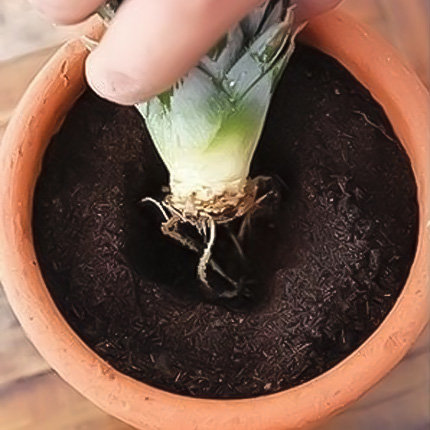
Make a small depression in the pot with the prepared soil mixture. Plant the top in it and gently sprinkle it with soil on all sides. Check if the stem is firmly seated in the ground. Now water the plant and make a shelter from a transparent film on top of it (like a greenhouse). Slightly lift the film from time to time so that the plant can breathe. When the top is fully rooted, the film can be removed. As practice shows, this happens after 30-45 days.
Pineapple Care
If a young pineapple often sheds leaves, this is not a reason to panic. The plant is simply refreshing itself constantly. The younger, stronger, and healthier leaves will soon grow up in place of the fallen ones. This process can be facilitated for the pineapple. To do this, you will have to carefully monitor the plant and remove dried leaves. However, if the leaves fall too frequently, this can also indicate that the pineapple is cold. It is better to check the temperature level in the room.
Watering
All gardeners recommend watering the plant with purified water, preferably with melted or rain water. In extreme cases, simple boiled water will also do. Additionally, the water must be made acidic with an ordinary citric acid. It must be warm – and ideally not lower than 28-30°C (~82-86°F). Pour water straight into the outlet, and when the soil is dry, repeat the procedure.
Top Dressing

The flower dressings of organic and mineral origin are suitable as fertilizers; preferably, the liquid ones due to the faster absorption. Apply the fertilizer once a month, which will be quite enough.
Transplanting
It is necessary to replant the pineapple by transshipment, without disturbing the soil clod with roots. The optimal period for this procedure is the beginning or middle of the spring. The new container should be slightly larger than the old one. A pot of up to 4 liters will be optimal even for a heavily overgrown shrub.
Be sure to select a fresh soil mixture. The transplant frequency should be once a year for a young pineapple; a full-grown one can be transplanted less frequently. If the pineapple is properly cared for, it will grow continuously throughout the year with no dormant period.
Diseases, Issues, Pests
The pineapple, like any other indoor plant, can suffer from diseases and insect pests. You can identify these problems visually.
- At too high temperatures, the pineapple leaves begin to dry and curl into tubes. Spray the plant well to prevent or mitigate this unpleasant occurrence. It is also recommended to put the pot in a shaded place for a while.
- With a lack of sunlight, the leaves become pale and weak. In this case, take care of additional lighting or move the pot to the lighter side of your apartment.
- With excessive watering, the stem begins to rot. Limit the amount and frequency of watering in this situation.
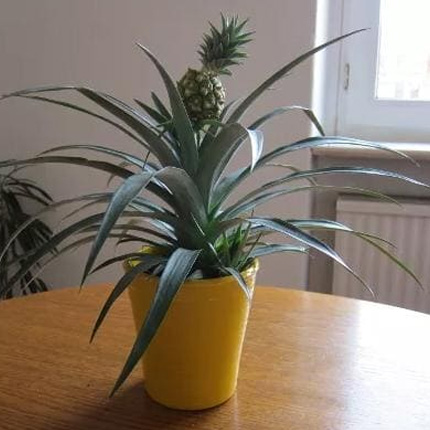
Improper houseplant care can provoke fungal diseases. A sign of damage by a fungus is brown spotting on leaf plates. If this happens, you will need to use a broad-spectrum fungicide. Treat the plant with it according to the instructions.
Unfortunately, insect pests, such as scale insects and false scale insects, spider mites, aphids, and mealybugs, are often found on the pineapple. At the initial stages of pest infestation, it will be enough to treat the plant with a soapy solution. The insecticides should help in advanced cases.
How to Make a Pineapple Bloom and Bear Fruit
The main disappointment when growing a pineapple is the lack of flowering. Usually the first flowers bloom by the third year of the plant’s life. However, flowering may not begin even under completely favorable conditions. But there is good news: flowering can be stimulated artificially. Several methods of such stimulation are known to date.
How to Stimulate the Pineapple Blooming
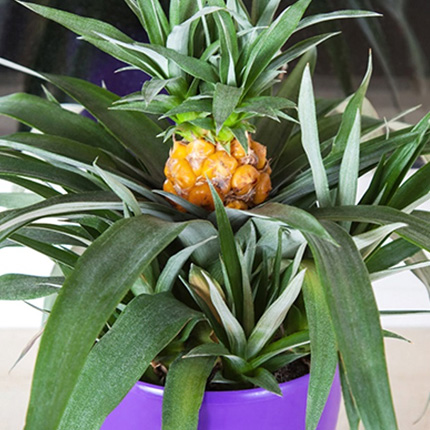
You will need a couple of ripe tomatoes or apples, as well as a regular plastic bag. Place the tomatoes or apples in the pineapple pot and seal everything with the bag. As soon as the fruits begin to rot, replace them with the fresh ones. If everything goes according to plan, the first bud will grow in a month.
Put coals that have been pre-heated on the stove near the pineapple pot for about ten minutes, covering the plant with a plastic bag. Repeat these actions three times, then take a week’s break and do it again.
Water the plant with a solution of calcium carbide in a volume of no more than 50 ml. To make a solution, you will need one teaspoon of powder to half a liter (~17 oz.) of water. Leave the mixture to stand for a day, and then filter it, removing the sediment. Overall, no matter what stimulation method you choose, the pineapple will bloom for only about two weeks, while the life of each inflorescence will be only one day.
Interestingly, the stimulation can lead not only to the blooming, but also to the fruiting of the pineapple. However, if the fruits never appeared, perhaps the plant is simply too young and immature. The fruits will also not appear in weakened species. On average, the plant’s maturation span is considerable: 6-7 months. This process depends not only on the conditions of cultivation and care, but also on the type of the plant. In the best case, you can get a pineapple weighing 1-1.5 kg (~2.2-3.3 lbs.), but that is if you are very lucky. Do not fertilize it with mineral supplements during the period of ripening, as this can slow down the development. After the fruiting stage, the pineapple will start a new shoot – use it to grow another one.
A Few Useful Tips for Growing the Pineapple at Home
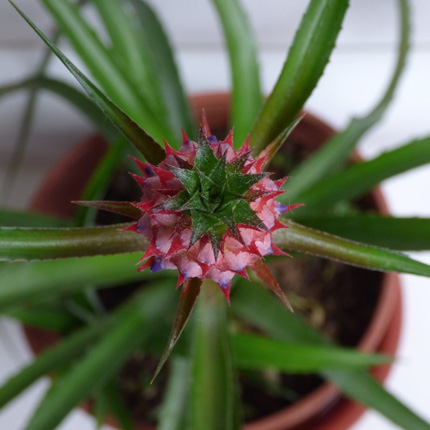
Growing this tropical fruit has its own nuances. If you know the subtleties, you can quickly grow a beautiful and healthy plant.
- So you have decided to grow a pineapple, have already bought a ripe fruit in the store, and cut off the top from it. Now leave it to dry in a vertical position. With this placement, the knife cut will heal faster and the nutrients will concentrate in the stem.
- When transplanting the pineapple, arrange a cap for the pot and leave it for a couple of days. This way, your pineapple can quickly get used to a new location.
- It is better to water the pineapple less often, but more abundantly. The moisture that will accumulate in its outlet will become a nutrient medium for the formation of young shoots.
- If you moved the plant to the yard for the summer, be sure to bring it back inside as soon as it rains. Also, do not forget to move it inside before the onset of the cold weather, i.e. at the end of August.
- Do not immediately tear off the new shoots from the flower. Wait a little and let them give root so that they are more likely to give life to another indoor pineapple.
- Start stimulating blooming in summer; this is the best time of the year for this purpose.
